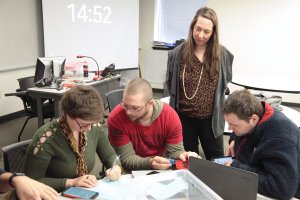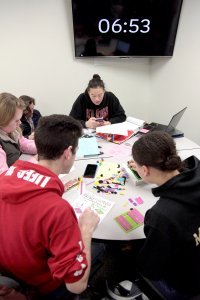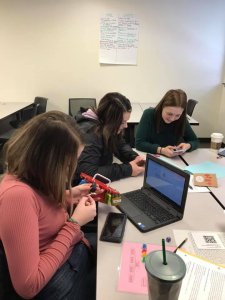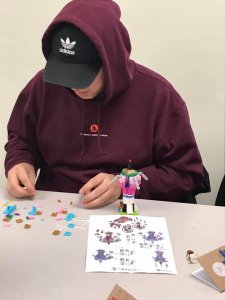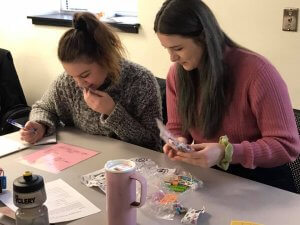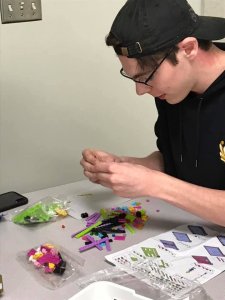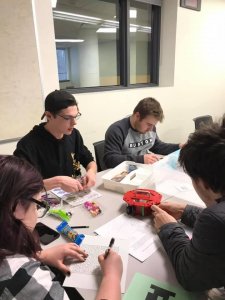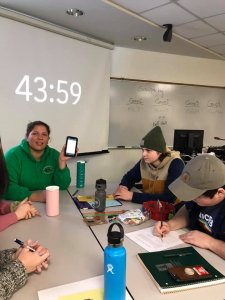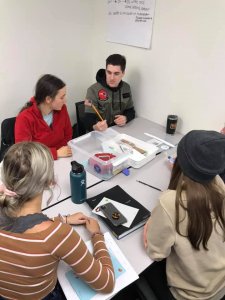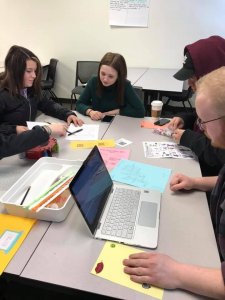Before I begin, I need to give credit and a shout out to Nick Roster, who inspired me with his own lock box activity. I had been wanting to do a group-styled “exam” for some time with my classes, and his idea of the “lock box” gave me the inspiration and vehicle to move my project from an idea into fruition.
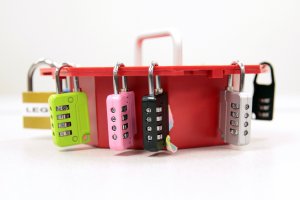
I had been thinking about this project for about six months — how could I create an activity – a check for understanding – that would require my students to put into action the steps of rhetorical thinking AND make them use their communication AND critical thinking skills (i.e. what we measure in our gen. ed. outcomes). After some trial and error, and running a trial with some former ENG111 students over break, I implemented my first (and not last) group exam: “Escaping the Rhetoric”.
There are eight tasks. Each task corresponds with a colored lock. When you finish the task, you will get a code to unlock a lock. Your task is to unlock all eight locks in 45 minutes. A giant timer (found from youtube.com) ran in the background on the ‘big screen’.
It wasn’t straight forward. Some directions were ambiguous. Some tasks didn’t have directions. Five of the eight tasks were directly linked to the course content: a crossword of Unit 1’s vocabulary, three QR codes to scan, each taking you to a separate online course content quiz, and an MLA formatting puzzle. The remaining three tasks were puzzles – one involving rainbow colored dice, a maze, and assembly of a lego set (approx 160-180 pieces). And did I mention that your group of 5-6 people had 45 minutes to complete these tasks? (Does this cause anxiety? YES! And it’s designed to do so).
Out of three groups, one finished the tasks with 3 minutes to spare. The remaining two groups had 1-2 locks left. They did not complete all of the tasks.
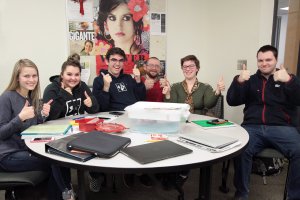
Yes – they were frustrated. They verbally shared that they were disappointed in themselves. This wasn’t easy. As the one who set this all up [in their eyes] “I was expecting too much…”. [yet, one group did finish with time to spare!] I digress.
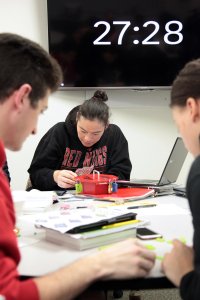
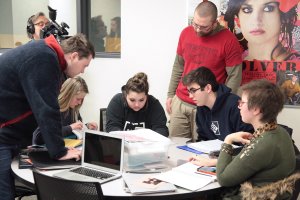
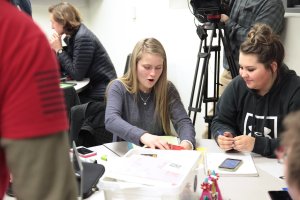
And this is where the real exam begins. The real assignment from this activity is the reflection. We processed individually (I have a fill in the blank / short answer page pre-made for them to fill out at the conclusion of the 45 minutes). We also debriefed as a group. A longer assignment reflection was attached to this as a second page.
Our group de-brief began with me talking through the processes they used to work together in a group — Listening, Searching for Understanding, Reflecting, and then Responding. These are the steps of “Rhetorical Thinking”. And in order to work together, they each had to put these practices into practice. And it was a process that would loop and repeat itself within the tasks and throughout the activity.
We also talked about how we “Establish Credibility” — in writing we do this by using good sources, using facts and statistics, identifying our bias, demonstrating our character, even appealing to emotion. In these tasks, students needed to establish their credibility by volunteering, explaining why they should take charge of a certain task, and show willingness to switch off of tasks if someone else volunteered that they could help/’do better’.
We discussed the critical thinking skills we put into place to decipher puzzles – deduction, analysis, common sense, reasoning, fact checking, and more. Time management was also key to success in these tasks. I took time to speak to our general education outcomes — the idea that each of our classes works to incorporate the applied learning areas of critical thinking and communication (among others). It’s not just about talking about these ideas – it’s putting them into action, acknowledging their roles in our success, and reflecting on how we can use/improve upon them in the future.
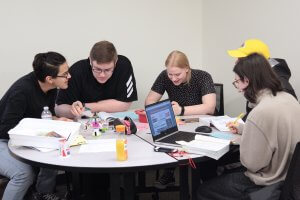
Working with others is not always easy. Especially when we are working with others we might not know well. We reflected together on what made for successful group-mates and what we learned about ourselves and others in this process. We talked about trust – we had to trust that everyone was working toward the end-goal – the success of the group.
This activity was designed to resemble something they might find out in the workplace — a task with a hard deadline, with ambiguous directions, and multiple pathways to the desired result. The parallels were not lost on students.
At the end of our group de-brief, I talked about Transformational Learning Theory, in particular, Mezirow’s ideas of “disorienting dilemmas”, and the idea that we needed to get uncomfortable and experience anxiety in order to learn other ways to approach situations and learning. These anxious feelings help ‘shake up’ our perspectives and paradigms. And ultimately, through reflection, allow us to see things in different ways, potentially transforming how we think and what we do.
We had an amazing, insightful de-brief, and I cannot wait to read the reflections which will come in over the next week. Students demonstrated course content, soft skills, and general educational outcomes. And they proved to me that they “get it” – it wasn’t meant to be easy or “fun” — it was meant to make them think.
Included are some pictures from my trial run with my ENG112 students. I hope to share some additional pictures from today with this post soon (like all teachers, I found myself too wrapped up in the lesson to stop and take photos….).
A special thank you to Dennis Schultz for coming out and videoing the groups. And to Cari and Meg from PR for taking some pictures. I look forward to sharing more about this lesson with others some time soon.
As always, feel free to follow up with me should you have any questions or want to implement something like this in your own classrooms.
